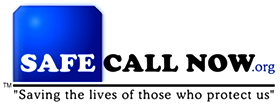with Sean Riley.png)

“It’s the dirty little secret everyone knows, but nobody talks about,” Sean Riley tells me when I ask about the statistic that should make every responder’s hair stand up on end. A first responder is more likely to die by their own hand than in the line of duty. The National Police suicide study for 2012 reports 126 police officer suicides. Over 30 suicides in 2011 were reported to the Fire Behavioral Health Alliance, as released in the 2012 report issued by the National Volunteer Fire Council. The numbers may be underreported or mislabeled in the statistics. Many states do not track suicides by occupation, and in his stunning presentation, Bill Prasad, Behavioral Health Coordinator for the Fairfax County Fire and Rescue, shows the suicide rate of NYPD officers as 29 per 100,000, more than twice that of the general population, at 12. In Chicago over an 18-month period, 7 firefighters committed suicide. These glaring statistics only count the completed suicides; many more attempts occur. These tragic deaths leave a gaping hole among the comrades, affecting not only the families, but entire communities.
The life events that make members of the general public at risk for suicide are often exacerbated by the perceptions responders have of themselves and the job, making them more at risk for suicide. Responders are “heroes,” “courageous,” “tough,” and “brave.” Fear that disclosing a personal problem or seeking help will affect employment, promotions, or recertification keeps many responders from reaching out in a crisis. This may be especially difficult for many rural and small-town responders who know everyone. Many are hesitant to seek local treatment for chemical dependency, depression, marriage difficulties, or financial troubles for fear the entire town would hear about it the next day. But help is there, for those who help the rest of us. There is a national resource available, for public safety first responders BY public safety first responders. This is a 24- hour crisis line, staffed by those who have been there. Safe Call Now is there to listen, and is a referral service for those who need it.
All Safe Call Now communications are confidential by law. The organization is based in Washington State, which passed legislation in 2009, RCW 43.101.425, entitling the caller to privileged communication. Whether or not there is a similar law in your jurisdiction, because the crisis line number (206) 459-3020 sits in Washington State, all calls are a confidential and privileged communication. This confidentiality encourages responders to reach out, and many of them do. Safe Call Now receives approximately 2,000 requests for help each year through phone or confidential e-mail. On the Safe Call Now website there is a “self-assessment” tool to assist responders who are unsure whether they should call.
“Sometimes just talking to another responder is enough to see that a problem isn’t really as big as you think it is, and the issue can be resolved through a phone call” Sean Riley explains. "But if the problem really is as big or bigger than you think it is, we have a referral service to the highest level of care for financial help, substance abuse, mental health issues, marriage counseling, depression, PTSD, and yes, suicide.” Sean started the non-profit Safe Call Now in 2009, after 20 years in law enforcement and overcoming his own battle with chemical dependency and contemplated suicide. The service is open to ALL emergency services, public safety personnel, and their families. "ER Nurses, Dispatchers, Firefighters, EMTs, Police, all responders can call.”
Overcoming the culture that prevents responders from reaching out for help must start with public safety leaders. Removing the stigma of seeking help for personal problems comes from the top down. This online self-assessment tool can and should be consulted by leaders to learn the warning signs that a member of the agency may be in crisis. Consider attending an accredited training symposium with Safe Call Now and receive CEUs while learning to support the personnel in your agency. One more suicide is one more too many. As Sean says, "Before you lose another friend, partner, spouse, one of your own, consider a simple call to us.”
Sometime during the month of September, download and print the brochure and the Safe Call Now FAQs for your station bulletin board from the Safe Call Now website. Then let your department know that the number is available for anyone who needs it.
For the Self-Assessment, visit the self-assessment page on SafeCallNow.org
To volunteer for this organization, email jkkakaley@safecallnow.org for an application.









